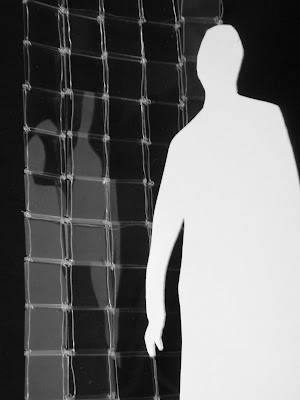
martes, 31 de marzo de 2009
martes, 24 de marzo de 2009
Shading Device Trials
As we are moving in the direction of a double or triple layered curtain system, here are some renderings of what a "shading" layer might look like...still working with the diamond-shaped geometry.
domingo, 22 de marzo de 2009
Walking Light Wall_Dynamic Shadow Studies
Wall movement shadow casting studies on site.
Wall rotational movement with multiple spot light sources.
Wall rotational movement with a single light source.
Wall rotational movement with multiple spot light sources.
Wall rotational movement with a single light source.
martes, 17 de marzo de 2009
martes, 10 de marzo de 2009
Possible compression technique

 Using a string through one of the mountain folds, the structure can be easily compressed by pulling on one end of the string. If we made a frame to hold the structure, we could use the servos with the micro controllers to pull on one end to create this compression. The servos would be placed at every third mountain fold to give slight variability throughout the structure. The servos could work independently in order to make a multitude of compressed and uncompressed states along the length of the wall
Using a string through one of the mountain folds, the structure can be easily compressed by pulling on one end of the string. If we made a frame to hold the structure, we could use the servos with the micro controllers to pull on one end to create this compression. The servos would be placed at every third mountain fold to give slight variability throughout the structure. The servos could work independently in order to make a multitude of compressed and uncompressed states along the length of the wall
Earlier wall studies cont
Earlier wall studies
irregular folds


This study used the same type of origami model as our previous study except that this one used a completely random set of folds to make the wall. The movement of this study follows the same type of compressing movement as the first, but it does not fully compress. However, this study creates a different set of geometries through the wall when compressed unlike the first.
Team O Geometry Exploration, continued


By creating a pocket on the surface, we were able to filter the colors and and direct the lights with more control.
When the surface is fully open, more lights pass through showing off the colors and when the surface is closed, less lights pass through making the Radiant Light Film almost invisible.
mountain folds / valley folds
 While trying to connect modular pieces presented on a previous blog "Radiant Light Film and simple geometry," we ran into trouble and frustration - mostly frustration. This led to simplifying the geometry into a square with one diagonal mountain or valley fold.
While trying to connect modular pieces presented on a previous blog "Radiant Light Film and simple geometry," we ran into trouble and frustration - mostly frustration. This led to simplifying the geometry into a square with one diagonal mountain or valley fold.Mountain fold is when the fold is raised up and valley fold is when the fold is pushed down.
To add a more irregular pattern, we decided to rely on chance and a coin. Head means mountain fold and tail means valley fold. After many coin tossing we ended up with these three different shapes.

Team O Geometry Explorations
Our first explorations dealt with the origami fold that Chris developed last week. The animation shows how the surface expands, but the geometry is not completely accurate as the surface areas of the faces are changing slightly.


Taking the original cut pattern and altering the vertices produces different variations in the fold pattern. Here are two screen shots of the definition file showing how the vertices can be altered according to some kind of logic, such as sine curve, or a linear curve. The results of the altered cut patterns are shown following the definition files.



 Now adding another layer of movement, we imagined the surface composition as something that can grow from a single point and expand to become a curtain or shading device.
Now adding another layer of movement, we imagined the surface composition as something that can grow from a single point and expand to become a curtain or shading device.

 To go a step further, if we reconfigure the folds of the original origami to align with each other we get a more 3-dimensional surface that could act as a shading device (still thinking about the interaction of these geometries with the 3M radiant light film). The openings vary according to the same logic that we developed earlier with explicit history (mapping vertices according to basic functions)
To go a step further, if we reconfigure the folds of the original origami to align with each other we get a more 3-dimensional surface that could act as a shading device (still thinking about the interaction of these geometries with the 3M radiant light film). The openings vary according to the same logic that we developed earlier with explicit history (mapping vertices according to basic functions)
Suscribirse a:
Comentarios (Atom)






































